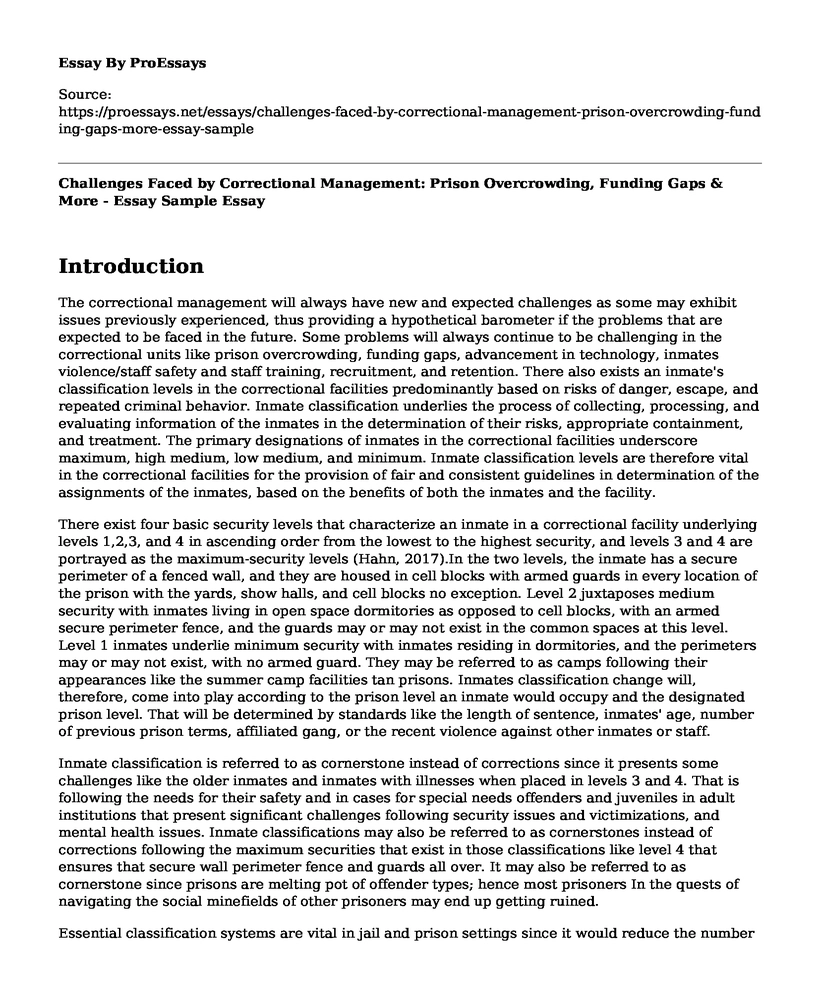Introduction
The correctional management will always have new and expected challenges as some may exhibit issues previously experienced, thus providing a hypothetical barometer if the problems that are expected to be faced in the future. Some problems will always continue to be challenging in the correctional units like prison overcrowding, funding gaps, advancement in technology, inmates violence/staff safety and staff training, recruitment, and retention. There also exists an inmate's classification levels in the correctional facilities predominantly based on risks of danger, escape, and repeated criminal behavior. Inmate classification underlies the process of collecting, processing, and evaluating information of the inmates in the determination of their risks, appropriate containment, and treatment. The primary designations of inmates in the correctional facilities underscore maximum, high medium, low medium, and minimum. Inmate classification levels are therefore vital in the correctional facilities for the provision of fair and consistent guidelines in determination of the assignments of the inmates, based on the benefits of both the inmates and the facility.
There exist four basic security levels that characterize an inmate in a correctional facility underlying levels 1,2,3, and 4 in ascending order from the lowest to the highest security, and levels 3 and 4 are portrayed as the maximum-security levels (Hahn, 2017).In the two levels, the inmate has a secure perimeter of a fenced wall, and they are housed in cell blocks with armed guards in every location of the prison with the yards, show halls, and cell blocks no exception. Level 2 juxtaposes medium security with inmates living in open space dormitories as opposed to cell blocks, with an armed secure perimeter fence, and the guards may or may not exist in the common spaces at this level. Level 1 inmates underlie minimum security with inmates residing in dormitories, and the perimeters may or may not exist, with no armed guard. They may be referred to as camps following their appearances like the summer camp facilities tan prisons. Inmates classification change will, therefore, come into play according to the prison level an inmate would occupy and the designated prison level. That will be determined by standards like the length of sentence, inmates' age, number of previous prison terms, affiliated gang, or the recent violence against other inmates or staff.
Inmate classification is referred to as cornerstone instead of corrections since it presents some challenges like the older inmates and inmates with illnesses when placed in levels 3 and 4. That is following the needs for their safety and in cases for special needs offenders and juveniles in adult institutions that present significant challenges following security issues and victimizations, and mental health issues. Inmate classifications may also be referred to as cornerstones instead of corrections following the maximum securities that exist in those classifications like level 4 that ensures that secure wall perimeter fence and guards all over. It may also be referred to as cornerstone since prisons are melting pot of offender types; hence most prisoners In the quests of navigating the social minefields of other prisoners may end up getting ruined.
Essential classification systems are vital in jail and prison settings since it would reduce the number of escapes and attempts to escape. Similarly, it would reduce the number of suicides and suicidal attempts among the inmates, together with inmates' assaults (Horgan, 2012). It would also ensure the safety of the inmates and the staff in the correctional facilities. Inmates classification would help in the maintenance of a safe and conducive environment for both inmates and staff as well as the safety of the public. The essential rating also helps the prison and jail department in deploying the scarce housing space and custody staffing, coupled with vital implications to the costs of the state. Additionally, since the system outlines a clear guideline on the supervision and housing of the inmates, it would positively affect the abilities of the inmates in earning credits and subsequent reduction of their sentencing.
References
Hahn, M. (2017, March). Classifying a Prisoner). Prisonology. Retrieved fromhttps://hahnscratch.com/2017/03/04/classifying-a-prisoner/
Horgan, G. (2012, May). Classification, The Engine that Makes Correctional Facilities Go.Corrections Media. Retrieved from http://www.corrections.com/news/article/31743classification-the-engine-that-makes-correctional-facilities-go
Cite this page
Challenges Faced by Correctional Management: Prison Overcrowding, Funding Gaps & More - Essay Sample. (2023, May 21). Retrieved from https://proessays.net/essays/challenges-faced-by-correctional-management-prison-overcrowding-funding-gaps-more-essay-sample
If you are the original author of this essay and no longer wish to have it published on the ProEssays website, please click below to request its removal:
- Essay Sample on Rights and Laws
- Trends in Crime Policy in the United States Paper Example
- Unilateral Rights and Exceptional Circumstances: Asda vs. Bateman Case Study
- The Difference Between Criminology and Criminal Justice Essay
- Essay Sample on Sunday Blues Laws Uphold 1st Amendment, Preserve Sabbath Day
- Reforming Criminal Activity: Examining Correctional Systems & Victims - Essay Sample
- Essay Example on Terrorism: The Rising Threat & Need for Collaboration







